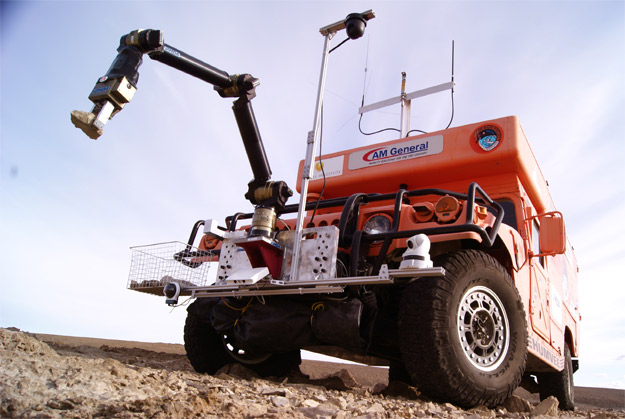A robotic arm will help astronauts take samples from asteroids, the Moon and Mars from within pressurized vehicles in the future. A team of international space scientists at the Mars Institute are working with the space robotics company MDA Information System Inc. to design and test a robotic arm that could help astronauts collect these geological samples.
 the Haughton-Mars Project's Mars-1 Humvee Rover, a simulator used by The Mars Institute and NASA to study pressurized vehicle operations for human space exploration. Image Credit: Haughton-Mars Project-2011/Mars Institute/MDA/Pascal Lee
the Haughton-Mars Project's Mars-1 Humvee Rover, a simulator used by The Mars Institute and NASA to study pressurized vehicle operations for human space exploration. Image Credit: Haughton-Mars Project-2011/Mars Institute/MDA/Pascal Lee
A series of field tests were conducted to see how the robotic arm could be used without necessitating the astronaut to go out on spacewalks. The robotic arm was operated by a human from inside a pressurized rover simulator. The tests were deemed part of the Haughton-Mars Project which is a multidisciplinary field research project.
It is based at the Haughton meteorite impact crater site on Devon Island in the High Arctic. The terrain here is seen as an analog for surfaces of the Moon, Mars and other asteroids due to its impact scarred, ice scoured and vegetation free nature. It is used often for key science operations testing.
As part of the field test an existing MDA-developed robotic arm was integrated to the HMP's Moon-1 and Mars-1 Humvee Rovers. These are used by both NASA and the Mars Institute as stand-ins for future pressurized space exploration vehicles, and deployed in the field to simulate planetary excursions.
Dr Pascal Lee, Director of the Haughton-Mars Project and lead scientist for the pressurized rover robotic arm study said that small pressurized vehicles were central to future human planetary exploration. They were learning here on Earth how best to use them to maximize the science return of future human missions to asteroids, the Moon, or Mars.